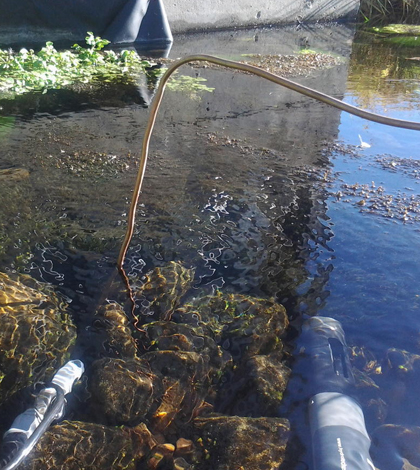Groundwater Age Foretells Colorado River Drought Vulnerability

Water quality and sampling equipment deployed at a spring site near Roaring Judy, Colo. (Credit: U.S. Geological Survey)
We know that the Upper Colorado River Basin gets most of its streamflow from groundwater. But perhaps a better question, especially in light of concern for increasingly common droughts, is how long it takes that water to pass through.
It’s an important thing to figure out because knowing just how much time it takes for groundwater to move through the basin is a marker of the resource’s availability. Longer transit time means that the impacts of drought may be softened, whereas shorter periods mean that upticks in temperatures and other dynamics supporting drought could dwindle waters away in a relatively smaller number of years.
In order to find out how quickly the groundwater passes through, scientists at the U.S. Geological Survey (USGS) have recently completed a survey of 19 streams around the basin. Theirs is the first such study to examine the short-term responses of groundwater on a regional scale by looking at the age of water.
To do that, investigators considered a number of environmental tracers like noble gases, tritium, radiocarbon and stable isotopes alongside water quality conditions of the springs in the region.
“Sampling 19 springs in a very large basin is just the start, and further studies are needed to better understand the groundwater resources of this specific region,” said John Solder, scientist at the USGS and lead author of a study detailing the effort published in the Hydrogeology Journal. “Determining groundwater age has promise in predicting how these systems will respond in the future and allows us to assess resource vulnerability where no historical records are available.”
Some tools used in the effort included multiparameter water quality sondes and handheld meters. Historical data on groundwater discharge also aided in modeling the changes over time and the delay in discharge due to drought conditions.

A scientist collects noble gas samples from a spring site near Roaring Judy, Colo. (Credit: Bert Stolp / U.S. Geological Survey)
Age-tracing techniques helped to assess how long it takes groundwater to travel from the point it enters aquifer systems as precipitation to when it exits through springs and streams. Scientists also compared data on eight of the springs with historical records on precipitation and discharge to groundwater age.
Results showed that groundwater discharge is less variable over time and takes longer to respond to drought conditions if springs contain older water. But springs with younger waters, 80 years old or less, were judged more likely to vary seasonally and respond rapidly to drought conditions, meaning young groundwater is more responsive to short-term variations in climate.
“About half of the springs analyzed in the Upper Colorado River Basin contained young groundwater, which was surprising,” said Solder. “These findings suggest that shallow aquifers, which are more responsive to drought than deeper systems, may be significant contributors to streamflow in the region.”
The study was funded by the USGS’ National Water Census, a research program focusing on national water availability and use at regional and national scales. Its aim is to provide information necessary for water and natural resource managers to make informed decisions.
Top image: Water quality and sampling equipment deployed at a spring site near Roaring Judy, Colo. (Credit: U.S. Geological Survey)




0 comments